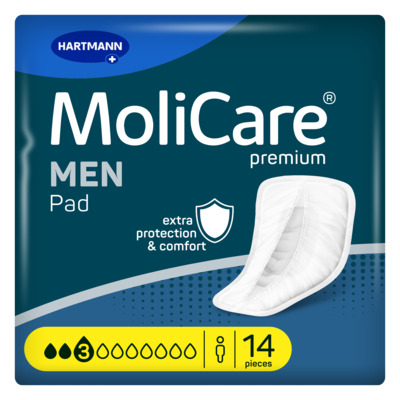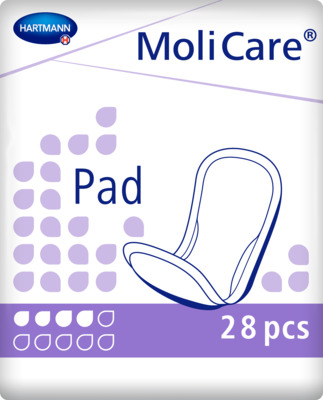Incontinence Advice
What Is A Hypertonic Pelvic Floor
This article, will enable you to learn about a hypertonic pelvic floor, exploring its causes, symptoms, and available treatment options. Whether you're experiencing pelvic pain, urinary difficulties, or discomfort during intercourse, understanding the hypertonic pelvic floor can improve your quality of life. The pelvic floor, a network of muscles and tissues supporting vital organs, plays a crucial role in maintaining our overall well-being. However, an often-overlooked condition known as the hypertonic pelvic floor can disrupt this delicate balance.
Make sure to stay up to date on our top tips for managing incontinence.

Hypertonic pelvic floor
Hypertonic pelvic floor is a condition characterised by a constant spasm or contraction of the lower pelvic muscles. Whether temporary or constant, this state of heightened muscle tension hinders the ability of the pelvic floor muscles to relax and coordinate the control of various bodily functions.
People with hypertonic pelvic floor may experience ongoing pain, especially during certain activities, as well as difficulties with urination and bowel movements. Additionally, this condition can lead to sexual dysfunction and painful intercourse.
Hypertonic Pelvic Floor: Causes, symptoms & treatment
- Sources
- Hypertonic pelvic floor
- Who does hypertonic pelvic floor affect
- How common is hypertonic pelvic floor
- Hypertonic Pelvic Floor Symptoms
- What causes hypertonic pelvic floor
- How is hypertonic pelvic floor diagnosed
- How is hypertonic pelvic floor treated
- How can I reduce my risk of hypertonic pelvic floor
- 3 Exercises for the hypertonic pelvic floor
- Breathing techniques for hypertonic pelvic floor
- When should I get medical help
- Can hypertonic pelvic floor be cured
- How to diagnose hyperbolic pelvic floor
- How to avoid having a hypertonic pelvic floor
- FAQs
Who does hypertonic pelvic floor affect
Having a hypertonic pelvic floor can affect both men and women of all age groups, but can have significant effects in the elderly, however, we can offer a wide range of incontinence pads to manage these effects.

How common is hypertonic pelvic floor
Hypertonic pelvic floor dysfunction is a common issue. It often goes
undiagnosed, and studies show that it affects about 1 in 10 people.
Hypertonic pelvic floor symptoms
One common symptom of hypertonic pelvic floor is pain. This pain can be felt as a general discomfort or pressure around the pelvic region, lower back, or hips. It can also be specific to certain locations, such as the bladder, or occur during activities like bowel movements or sex.
Other symptoms include:
Urinary symptoms
● Bladder pain.
● Pain when passing urine
● Excessive urination.
● Struggling to maintain a urinary stream.
Bowel symptoms
● Struggling with bowel movement (pooing).
● Feeling like you’re unable to empty completely.
● Pain during pooing (constipation).
● Pain with the passing of wind.
Sexual symptoms
● Pain during or after sexual intercourse.
● Failing to reach orgasm.
● Erectile dysfunction; pain with ejaculation.
Symptoms of hypertonic pelvic floor tend to develop gradually and
worsen over time. It is important to discuss even mild symptoms with your GP.
What causes hypertonic pelvic floor
The causes of hypertonic pelvic floor can be complex. Certain factors can increase the risk of developing this condition, including:
- Holding in urine or stool: Some people may develop the habit of holding in urine or stool. in childhood if this occurs it can continue into adulthood. Others may do so due to their lifestyle or job.
- Injury or trauma to the pelvic muscles: Pelvic muscles can be affected by surgical procedures, pregnancy, childbirth, or traumatic accidents, leading to hypertonic pelvic floor.
- Muscular dysfunction due to sitting, posture, or gait issues: Prolonged sitting, abnormal posture, walking with an irregular gait, or uneven pelvic bones can contribute to the development of hypertonic pelvic floor.
- Other pain-causing conditions: Conditions like irritable bowel syndrome (IBS), endometriosis, vulvodynia, anal fissures, and painful bladder syndrome, can be associated with hypertonic pelvic floor.
- Sexual or physical abuse: Those who have experienced sexual or physical abuse may be at a greater risk of developing hypertonic pelvic floor.
- Stress, depression, and anxiety:
Mental health factors such as stress, depression, and anxiety can also
contribute to the development of this condition.
How is hypertonic pelvic floor diagnosed
When you visit your GP, they will ask about your symptoms and medical history. This includes questions about your bowel movements, urination, and sexual activity. Talking about these topics may be embarrassing or challenging, however it is important to openly discuss any problems you are experiencing. This will assist your GP in making an accurate diagnosis.
Your GP will likely conduct a physical
examination, which may involve:
● Visual inspection of your pelvic area: They will observe how well you can contract and relax your pelvic floor muscles.
● Digital rectal exam: This examination checks the rectum and anus.
● Pelvic exam: This exam evaluates the vagina.
Your GP may also perform additional tests such
as:
● Anorectal manometry: This test involves inserting a thin tube (catheter) with a balloon into your rectum. The balloon inflates, and the contractions and relaxations of your rectum and anus are recorded and measured using a machine.
● Electromyography: Surface electrodes are placed on your skin to measure the electrical signals of your muscles as they contract and relax. Adhesive pads hold the electrodes in place.
● Defecography: This test examines your bowel movements. It involves placing a special contrast substance (barium paste) into your rectum and taking X-ray pictures while you defecate on a special toilet. Bowel preparation, similar to that before a colonoscopy, is necessary to clean out your rectum and colon before the test.
● Urodynamic
tests: This is a series of tests performed together to assess your
urination process and bladder function. These tests provide information on how
well you pee and how your bladder works.
How is hypertonic pelvic floor treated
Physical therapy is the main treatment for hypertonic pelvic floor, aiming to retrain your muscles. Your GP will recommend a physical therapist who specialises in pelvic floor dysfunction. Physical therapists tend to recommend the following treatments for hypertonic pelvic floor:
● Biofeedback: Teaching you how to properly contract and relax your muscles using feedback techniques.
● Relaxation techniques: Targeting the pelvic area and abdominal wall to promote relaxation.
● Massage, stretching, and joint movements: Employed to relieve muscle tension and enhance flexibility.
Additional treatments that your GP may suggest including:
● Acupuncture: Using fine needles to stimulate specific points in the body for symptom management.
● Medications: Prescribing medications to alleviate symptoms like pain, anxiety, constipation, or frequent urination.
● Nerve stimulation: Utilising nearby nerves to address urinary or bowel incontinence.
Your GP may also involve other specialists, such as:
● Gastroenterologist: To address constipation and evaluate pelvic floor-related issues.
● Colorectal specialist: For pelvic floor disorders associated with bowel movements.
● Gynaecologist: For managing reproductive health concerns in individuals assigned female at birth.
● Urologist or urogynaecology’s: To address urinary problems or sexual dysfunction.
● Psychotherapist: To address psychological factors related to the condition.
●
Sex
therapist: For the treatment of sexual dysfunction.
How can I reduce my risk of hypertonic pelvic floor
To lower your risk of hypertonic pelvic floor, it's important to grasp the concept of contracting and relaxing your pelvic muscles. Additionally, you can take the following steps:
- Engage in mindfulness and relaxation techniques to alleviate muscle tension.
- Perform pelvic floor exercises during and after pregnancy to maintain muscle strength.
- Strengthen your pelvic floor through yoga exercises.
- Prevent constipation and avoid straining during bowel movements.
- Seek medical attention if you experience pelvic or anal pain.
- Seek psychological support if you have experienced trauma.
- Avoid extended periods of holding in urine or stool.
Adopt shaped incontinence pads into your underwear routine to help manage any
leakages.
3 exercises for the hypertonic pelvic floor
Here are three exercises that you should try to lessen the symptoms of a hypertonic pelvic floor. Perform these exercises at a relaxed pace and focus on proper breathing to allow the pelvic floor to fully relax.
- Butterfly Exercise: This exercise targets the adductor muscles. Aim to gently move your knees up and down, resembling the wings of a butterfly.
- Squat: Engaging in squats helps reduce the tension in your pelvic floor muscles. Lower your body into a squatting position, keeping your back straight and heels on the ground.
- Child's Pose: This pose helps open up the adductor and glute muscles. Kneel on the floor and then lower your upper body forward, stretching your arms out in front of you as you rest your forehead on the ground.
Remember, be patient with these exercises and focus on breathing correctly to maximise the relaxation of your pelvic floor muscles.
Breathing techniques for hypertonic pelvic floor
Performing these breathing exercises at home will greatly benefit you when done properly, and aid in controlling a hypertonic pelvic floor.
● Diaphragmatic Breathing: Focus on deep breathing using your diaphragm. Take a deep breath, let your belly rise, and then exhale slowly as your belly falls.
● 360° Breathing: Expand your breath throughout your whole torso. Take a deep breath, feel your ribs expand outward, and then exhale completely as your ribs naturally contract.
● Alternate Nostril Breathing: Breathe in through one nostril while closing the other, and then switch nostrils for each breath. It helps balance and calm the mind.
Here’s what to do if you are dealing with incontinence anxiety.

When should I get medical help
If you experience pelvic pain, difficulties urinating, discomfort during bowel movements or sex, it's important to see your GP. These symptoms often don't go away on their own, so seeking medical care is advised.
Hypertonic pelvic floor can cause
uncomfortable and embarrassing symptoms such as pain and difficulties with
urination, bowel movements, and sexual activity. The great news is that
treatments like physical therapy can work. By talking to your GP about your
symptoms as soon as possible, this will guide you to get the right treatment.
Can hypertonic pelvic floor be cured
Discussing private gynaecological problems can make people uncomfortable, embarrassed even when talking to healthcare providers or clinic staff. However, it's important to seek treatment because these issues are unlikely to go away on their own.
The good news is that most cases of overactive
pelvic floor muscles can be treated successfully. By addressing the underlying
muscle problems, the associated symptoms can be resolved.
How to diagnose hyperbolic pelvic floor
When seeking help for this condition, it's important to give your GP your complete medical history and be prepared to talk about your bathroom habits, sexual history, and specific symptoms. Sharing these details will help your doctor make an accurate diagnosis.
In addition, a physical examination will be done, which may include a check inside your vagina to assess the function of your pelvic floor muscles. There may also be an examination of your anus muscles called a rectal exam.
Based on the initial assessment, further tests may be needed.
Once the investigations are finished, your GP
will create a plan to restore your pelvic floor to its normal state and relieve
the symptoms.
How to avoid having a hypertonic pelvic floor
In summary, hypertonic pelvic floor is a
condition where the muscles in the lower pelvis are constantly contracted or
spasming. Its symptoms can greatly affect a person's life quality, causing
pelvic pain, problems with urination and bowel movements, and sexual issues.
Getting medical assistance is essential because a proper diagnosis and
treatment, such as physical therapy and other interventions, can bring relief
and enhance overall well-being.
[No text in field]
FAQs
What are the options for treating hypertonic pelvic floor?
The treatment for hypertonic pelvic floor can involve pelvic floor physiotherapy, which includes techniques like manual therapy, stretching exercises, relaxation exercises, biofeedback, and learning about posture and lifestyle adjustments. In certain cases, additional interventions such as medication or counselling might be suggested.
Can lifestyle changes help with hypertonic pelvic floor?
Absolutely! Making certain lifestyle changes can be helpful in managing hypertonic pelvic floor. These changes may include practising stress reduction techniques, incorporating relaxation exercises into your daily routine, maintaining good posture, practising diaphragmatic breathing, and avoiding activities that can increase pelvic floor tension.
How long does it take to see improvement with treatment for hypertonic pelvic floor?
The time it takes to see improvement can vary from person to person. Some people may start experiencing relief of symptoms within a few weeks of beginning treatment, while others may need several months of consistent therapy. It's important to follow your GP’s advice and be patient throughout the healing process.
Sources
NHS. (n.d.) Help after rape and sexual assault. [online] Available at:
https://www.nhs.uk/live-well/sexual-health/help-after-rape-and-sexual-assault/
[accessed 14/07/23]

MoliCare® Premium Lady Pad 2 Drops
<h2>Skin Friendly Pant Liners</h2> <p>For women that experience slight incontinence and bladder weakness, across different age groups, it can be a challenge to find the right bladder weakness product that is easy to apply and wear without the worry of potential leakages. Fortunately, we understand this approach, hence why we are happy to offer our MoliCare® Premium Lady Pad 2 drops, that is skin-friendly, Aloe Vera applied, and comes with 14 liners per bag.</p> <h2>Slim and discreet liners</h2> <p>Whether dealing with stress incontinence or urge incontinence, these panty liners offer a discreet and easy solution on the go. Simply place the pad in your underwear and secure it with the adhesive strip for all-round protection. Available in different absorbency levels, MoliCare® bladder weakness products cater to all levels of bladder weakness, ensuring secure care.</p> <h2>Control Bladder Weakness</h2> <p>Enjoy the benefits of these body-shaped absorbent panty liners, designed for women with bladder weakness. The pads offer discreet, reliable protection with features including odour control and fast absorption.</p> <p>With a wide adhesive strip, you can comfortably fix the pad in your regular underwear, providing secure and comfortable fixation. The pads are skin-friendly, featuring soft, breathable materials, including foam cuffs, and a top sheet treated with Aloe Vera.</p> <p>Keeping your skin healthy is a priority, which is why MoliCare® Premium Lady Pads have a skin-neutral pH value of 5.5 and an antibacterial finish. They are also dermatologically tested, offering peace of mind.</p> <h2>Buy pant liners online</h2> <p>Never worry about running out with our convenient order service and fast delivery direct to your door. Enjoy free shipping on orders over £50.</p> <p>If you need assistance, our professional customer service team is here to support you in choosing the right product. Reach out to us today at 0800 028 9470 and experience the comfort and reliability of MoliCare® Premium Lady Pads.</p>
MoliCare® Premium Men Pad 3 Drops (ISO 441ml)
<p><strong>Reliable and discreet incontinence pads for men with an instant-dry feeling</strong></p> <p>Bladder weakness is difficult to live with, the last thing you want to worry about is incontinence protection. That’s why our best-ever MoliCare® premium MEN Pad 3 drops offer an <strong>all-round protection</strong> that keeps everything dry and comfortably in place while fitting discreetly in your regular underwear.</p> <p>The incontinence pad for men quickly <strong>removes urine from the surface up to 86 %* faster than before</strong> and neutralises unpleasant odours to leave you feeling instantly dry and in control thanks to the new <strong>MoliCare SkinGuard</strong>®<strong> Absorbent Core Technology</strong>. This skin-friendly technology not only helps you feel up to 90 %* drier than previous MoliCare® premium<strong> </strong>MEN pads, it also helps to maintain healthy skin and preventing irritation.</p> <p><strong>Engineered for the male anatomy</strong> and dermatologically tested for maximum skin compatibility, these male urinary pads do not contain colour, perfume or latex making them environmentally friendly too.</p> <p>*Compared to last generation</p>
MoliCare® Pad 4 Drops
<h2>Handy MoliCare incontinence pads to carry on the go</h2> <p>Our MoliCare® Pad 4 Drops are an essential product for those experiencing slight incontinence, allowing you to regain control and live your busy and active life without the interference of bladder weakness. Designed for both men and women, this incontinence pad for men and women offers exceptional dryness and protection, ensuring your comfort and confidence.</p> <h2>‘Barely There’ Reassurance and Reliability</h2> <p>The MoliCare® Pad 4 Drops are slimline, discreet, and adjusted to fit your body seamlessly. It fixes securely inside your underwear, providing a ‘barely there’ comfort feel. With its soft and skin-kind fabric, along with a wide adhesive fixing strip on the backsheet, you can go about your day with the assurance of being protected against leakages.</p> <p>The absorbent core effectively prevents your skin from becoming too moist, while the elastic anti-leak edging adds an extra layer of security and peace of mind. Say goodbye to any worries about odours, as the MoliCare® Pad 4 Drops also neutralises odours to keep you fresh and confident throughout the day. Don't let incontinence hold you back from living life to the fullest.</p> <p>Ordering your MoliCare® Pad 4 Drops is hassle-free, as we offer fast delivery direct to your door. With our price match promise, you can trust that you're getting the best value for your money. Plus, enjoy free delivery on all orders over £50.</p> <p>If you need assistance in finding the perfect incontinence product for your needs, our friendly customer care team is here to help. Don't hesitate to reach out to us at 0800 028 9470. Take control of your life with the reliable protection and comfort of the MoliCare® Pad, alongside other <a href="https://www.hartmanndirect.co.uk/incontinence-products/incontinence-pads" style="color:#0563c1; text-decoration:underline">incontinence pads</a>.</p>
